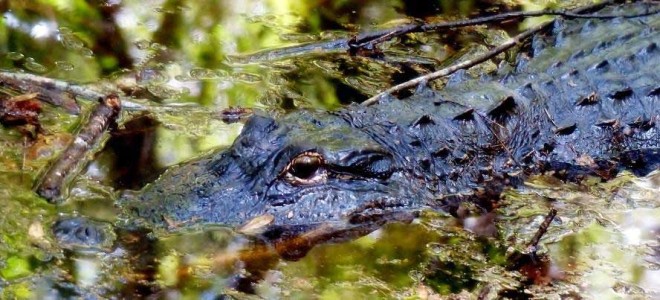by Patrick Higgins
Anyone who sails in the skinny waters of the Ten Thousand Islands, as l regularly do on my catamaran Tropicbird, will occasionally bump the bottom. And so I suppose it’s inevitable that if you stomp around the swamp often enough, you will eventually step on an alligator. I did so for the first time a few weeks ago.
Far from scary it was quite Pythonesque (of the Monty variety). Mike Owen and I were alone deep in the Fak, about 1,000 yards west of East Main surveying some ghost orchids. It was just before the September deluge and water was scarce.
We found ourselves in a broad, shallow depression where there was still 6-8” of water and were focusing on pop-ash trunks about 6 feet above the ground. Mike was ahead as I was determined to make my own discovery, which I didn’t, of course – at least, not of a ghost.
As I put my foot down, a gator whipped around in a lightning splash and grasped onto it. Now, you have to look at this from the poor gator’s perspective. It had nowhere to go as there wasn’t water elsewhere; so it probably had elevated down as I approached, pressing itself hard against the bottom to gain a few inches of cover. It can’t be pleasant to have 240 pounds step on your back. Its reaction was purely defensive.
Luckily I was already raising my foot as its teeth fastened onto my boot, so it had a grip on the sides on my sole rather than the top of my foot where I would have felt the bite force. Also, it was only a five-footer.
So there we were; the gator’s teeth stuck momentarily in the rubber sides of my boot’s sole and me hopping backwards on one leg dragging the creature with me whilst trying to keep my balance with my stick – all the while trying to shake the darn thing off and shouting, “Mike, I got a five foot gator on my foot!” This impasse lasted only a few seconds. I think the gator was as keen to let go as I was for him to do so and maybe even had his teeth stuck.
Mike almost stepped on a cottonmouth coiled on a dry patch during the distraction but was most solicitous, insisting if there was any skin broken I go to the hospital because of the risk of infection. But the only injuries were my pride and a few small perforations in my boot sole. I did get some kudos, though, because scientist to the end, even in my excitement, I hadn’t exaggerated the gator’s length. When we approached him afterwards sure enough he was five feet, and with nowhere to hide, he rotated around to face us and scowled.
I suppose seeing the humor of the moment even as it happened comes from a long, albeit sporadic, association with reptiles. Growing up my father wouldn’t allow us to keep any pets that could harbor fleas, and so by eleven years old I had a caiman living in my bath tub and a collection of snakes and lizards.
I should mention for the benefit of those whom I lead on swamp walks, that it was entirely my own fault and that when I lead the public groups I always pre-reconnoiter the route so I can concentrate on their safety and enjoyment. In any case, our swamp walks are during the cooler months when gators are less active or inactive. As I often tell my parties: they normally avoid humans, don’t feed when the water temperature is below 70°, and like all predators are very cautious about injury so won’t tackle prey bigger than themselves. And even if you’re not six foot one like me, when you’re in a group you seem like a big organism.
I’ve never actually encountered an alligator on a public swamp walk in the water. If we see one it’s usually on the tram and by that, in case I’m alarming any potential tram tour participants, I mean on the old logging trails which in the Fakahatchee we have come to call trams, not on the tour vehicle! But just knowing they are out there, along with black bears and panthers, adds to the enjoyment of being in one of Florida’s last remaining wilderness areas.
Patrick Higgins is a National Association of Interpretation Certified Interpreter, Vice-President of the Friends of Fakahatchee and Project Manager for the development of the Boardwalk Master Interpretive Plan.

